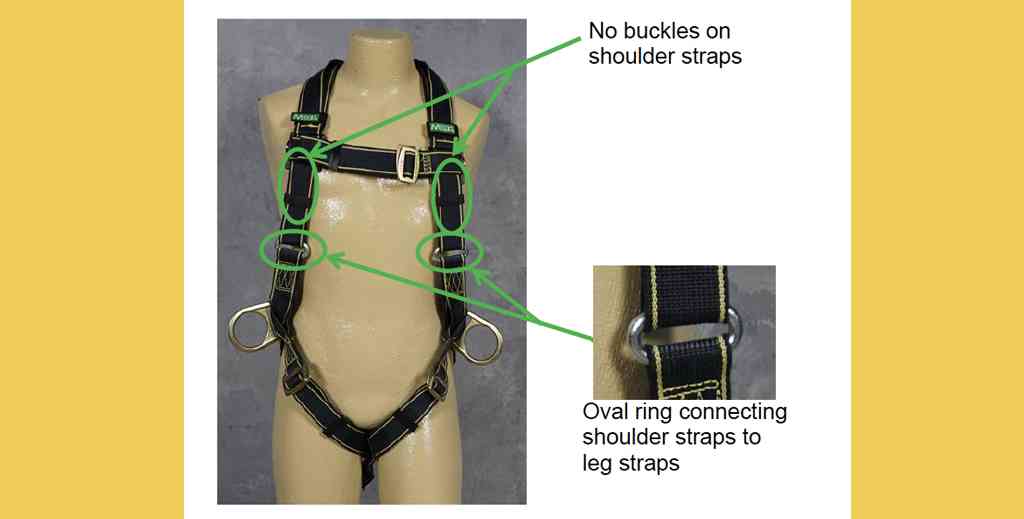INSPECTIONS
GENERAL GUIDELINES – SEE MFG INSTRUCTIONS FOR SPECIFICS
To see the inspection form, click here.
HARNESS
FREQUENCY
1) Must be inspected by user before each use.
2) Must be inspected by a competent person other than the user at least annually. Must be recorded.
INSPECTION STEPS
1) Inspect harness hardware (ie. Buckles, D-rings, back pad, keepers, etc.). These
items must not be damaged, broken, distorted, or have any sharp edges, burrs, cracks, worn
parts, or corrosion. Make sure buckles work freely.
2) Inspect webbing – Material must be free of frayed, cut, or broken fibers – Check for tears,
abrasions, mold, burns, discoloration, etc. Inspect stitching – Check for pulled or cut stitiches.
Broken stitches may be an indication that the harness has been impact loaded and must be
removed from service.
3) Inspect labels – All labels should be present and fully legible. Labels must be replaced if
illegible or missing.
4) Inspect each system component or subsystem per associated manufacter’s instructions.
5) If annual inspection, record inspection in log.
LANYARD
FREQUENCY
1) Same as for harnesses.
INSPECTION STEPS
1) Inspect energy absorbing laynard hardware (ie. Snap hooks, adjusters, swedges, thimbles, etc.) –
These items must not be damaged, broken, distorted, or have any sharp edges, burrs, cracks,
worn parts, or corrosion. Make certain the connecting hooks work properly. Hook gates must
move freely and lock upon closing. Make certain adjusters (if present) work properly.
2) Inspect the following that is applicable:
A) Webbing and stitching: Inspect webbing- material must be free of frayed, cut, or broken
fibers – Check for tears, abrasions, mold, burns, discoloration, etc. Inspect stitching – Check
for pulled or cut stitches. Broken stitches may be an indication component has been impact
loaded and must be removed from service. The webbing must be free of knots, excessive
soiling, heavy paint buildup, and rust staining. Check for chemical or heat damage (this
type of damage may show up as brown, discolored, or brittle areas). Check for ultraviolet
damage (this type of degradation is indicated by discoloration and the presence of splinters
on the webbing surface). Damaged or questionable webbing should be replaced.
B) Synthetic Rope: Inspect rope for concentrated wear – Material must be free of frayed strands
and broken yarns, cuts, and abrasions, burns, discoloration, etc. The rope must be free of
knots, excessive soiling, heavy paint buildup, and rust staining. Rope splices must be tight,
with five full tucks, and thimbles shall be held by the splice. Check for chemical or heat
damage. Check for ultraviolet damage. Damaged or questionable ropes should be
replaced.
C) Wire Rope: Inspect entire length of wire rope. Always wear protective gloves when inspecting
wire rope. Inspect for broken wires by passing cable through your gloved hands flexing it
every few inches to expose breaks. Broken wires can be removed by bending the wire back
and forth parallel to the rope length. Do not attempt to pull wires out of rope. Replace the
wire rope if there are six or more randomly distributed broken wires in one lay, or three or
more broken wires in one strand in one lay (a lay of wire rope is the length of wire rope that
it takes for a strand (the larger groups of wires) to complete one revolution or twist along the
rope). Replace the wire rope if there are any broken wires within 1 inch of the metal
compression sleeves (swedges) at either end of the assembly. Wire rope should be free
of corrosion.
3) Energy Absorbing Component: Inspect energy absorber to determine if it has been
activated, there should be no evidence of enlongation. Make sure energy absorber cover is
secure and not torn or damaged.
4) Inspect labels – All labels should be present and fully legible. Labels must be replaced if
illegible or missing.
5) Inspect each system component or subsystem per associated manufacturers instructions.
6) If annual inspection, record in log.
Thanks for the share WK!



